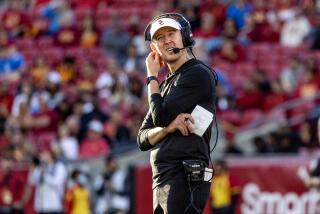Playground Dangers, Healthful Sponsors
- Share via
Following is one in an occasional series of notes on some possible trends, current or future, in the consumer marketplace:
Parents may be surprised by the hidden perils in children’s playgrounds. Although 75% of playground injuries are caused by falls, 114 of 130 playgrounds surveyed nationwide lacked protective surfacing, reports the U.S. Public Interest Research Group and the Consumer Federation of America. Moving swings and strangulation hazards also cause serious injuries, but 78% of playgrounds with swings don’t space swings safely and 24% use swings of heavy rigid material; at 58%, the play equipment could entrap children’s heads.
More surprising are the parents who see no peril in adult-sized ATVs (all-terrain vehicles), which killed 77 children under 16 and injured 19,400 in 1990, the U.S. Consumer Product Safety Commission says. Injuries and deaths from ATV-related accidents declined overall from 1986 to 1990, but children still accounted for 40% of them.
Sports sponsorship is getting healthier. One of the race cars in the Indianapolis 500 had the slogan “Tobacco-Free America” on its camera side and the international no-smoking symbol on its nose. Billed as a “counter-promotion,” given the heavy presence of tobacco companies, the car was endorsed by a coalition including the American Lung Assn. and American Cancer Society, and sponsored by Indianapolis’ Head and Neck Cancer Rehabilitation Institute and a life insurance company.
It did well too, coming in 12th in a race that only a dozen cars finished. This could lead to tennis tournaments sponsored by drug companies selling anti-smoking patches and nicotine gum, Monday night football brought to us by Alcoholics Anonymous and DARE, Saturday cartoons by book publishers.
Bridgestone Tire wants to educate 15 million women this year about tire and auto care--a long-term bastion of male superiority, along with insider trades, S&L; crime and serial killing.
The campaign began three years ago after a study indicated that 49% of new cars are bought by women and that 56% of women are “involved in” tire purchases and 39% do the buying.
Bridgestone’s program, apparently based on the assumption that these women were buying blind, includes a booklet of “Tire Tips” and a series of personal appearances by race car driver Pat Lazzaro. Both cover a range of topics of seemingly unisex appeal--from tread-wear ratings to race track driving tips.
Never mind the endless haggle over whether a 2% drop in credit card interest rates would be good for consumers, the economy or card companies. Credit Card News, a Chicago-based industry newsletter, has noted some potential developments that could really change the whole business:
Bank cards are edging out retail store cards, whose market share has dropped from 41% to 14% since 1981, reports Purdue University’s Credit Research Center. Forty percent of consumers making a purchase now use bank cards instead, preferring to carry fewer cards and get a single monthly statement. The 60% who stick to store cards do so mostly to get catalogues and sale notices.
Card ownership among college students--prime targets for card issuers--has declined after growing more than a third from 1988 to 1990. The number of students holding at least one major credit card fell 17% from October, 1990, to October, 1991, according to the market research of Roper CollegeTrack. Roper attributes the fall-off to tighter resources and to either the students or their parents pulling back.
Credit card issuers are talking about cutting grace periods down or out to make up for money lost by cutting annual fees or lowering interest rates. Bankers would welcome the change, but there’s a downside. According to Atlanta-based Synergistics Research Corp., 43% of convenience users (who pay in full each month) and 23% of revolvers (who carry a balance) would cancel such cards; others would use them only for some purchases, and not as often.
Finally, a couple of surveys briefly noted:
Almost half the time (46%) that Americans have headaches, colds, or injuries, they “tough it out” or try home remedies. Only 17% of such problems are taken to doctors, and 38% are treated by non-prescription over-the-counter medicines--the latter percent barely changed since 1983 despite heavy advertising. (Source: the Nonprescription Drug Manufacturers Assn.)
Presented with five possible factors that could encourage them to spend more and help the economy, 12% of surveyed credit cardholders went for a reduction in taxes, 10% a reduction in credit card interest rates, and a third chose a salary increase, i.e. more money. What a surprise. (Source: Visa U.S.A.)
More to Read
Inside the business of entertainment
The Wide Shot brings you news, analysis and insights on everything from streaming wars to production — and what it all means for the future.
You may occasionally receive promotional content from the Los Angeles Times.










